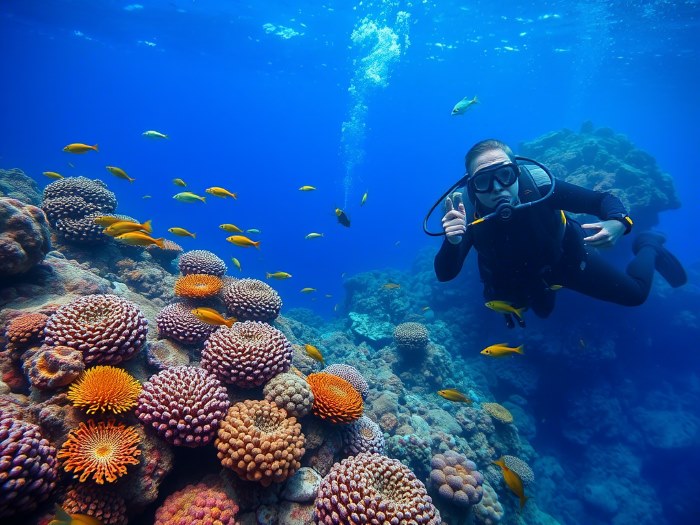India’s vast coastline and archipelagoes hide a world of underwater marvels that rival global diving hotspots. Beyond the well-trodden beaches lie pristine ecosystems, volcanic landscapes, and submerged historical treasures waiting to be discovered. This article unveils India’s best-kept marine secrets, offering a guide to exploring these untouched paradises responsibly.
1. Barren Island: Where Fire Meets the Sea
Nestled in the Andaman Sea, Barren Island is India’s only active volcano, offering a surreal blend of geological drama and marine biodiversity. The island’s volcanic slopes plunge into turquoise waters teeming with life, including manta rays, reef sharks, and vibrant coral gardens . Though landing on the island is restricted due to safety concerns, boat tours and diving excursions allow visitors to witness its smoking crater and explore underwater lava formations. The best dive sites, such as Purple Haze and Manta Point, reveal iridescent corals and pelagic species like pilot whales and barracudas .
Key Highlights:
- Volcanic Activity: Eruptions since 1787 have shaped its rugged terrain, creating a dynamic seascape .
- Diving Season: February to April offers optimal visibility (up to 40 meters) .
- Permits: Special permissions are required due to its protected status .
2. Lakshadweep: The Emerald Archipelago
The Lakshadweep Islands, scattered in the Arabian Sea, are a haven for divers seeking tranquility. With limited tourist infrastructure, sites like Agatti Island and Bangaram Atoll boast untouched coral reefs, nurse sharks, and schools of barracuda . The Princess Royal wreck, a 200-year-old warship near Kadmat Island, adds historical intrigue to dives, where ancient pottery and cannons lie amid thriving marine life .
Why Visit?
- Exclusivity: Only accessible via government-regulated tours (SPORTS) to preserve its ecosystems .
- Marine Diversity: Spot turtles, dolphins, and the rare dugong in seagrass meadows .
- Best Time: December to April for calm seas and clear waters .
3. Netrani Island: Karnataka’s Underwater Playground
Off Karnataka’s coast, Netrani Island (Pigeon Island) is a magnet for adrenaline seekers. Its deep blue waters host whale sharks, reef sharks, and manta rays, while underwater caves and canyons challenge experienced divers . The island’s heart shape and crystal-clear visibility make it a photogenic hotspot, ideal for advanced drift dives .
Dive Essentials:
- Top Sites: The Grotto and T-55 for pelagic encounters .
- Season: September to April avoids monsoon turbulence .
- Accessibility: A 2-hour boat ride from Murudeshwar .
4. Tarkarli: Maharashtra’s Budget-Friendly Paradise
For beginners, Tarkarli in Maharashtra offers shallow, calm waters with vibrant coral reefs and seahorses. At just ₹500–₹1,000 per dive, it’s one of India’s most affordable destinations . The King’s Garden site dazzles with rare frogfish and ghost pipefish, while snorkelers can explore depths up to 30 feet without certification .
Added Perks:
- Historical Proximity: Combine diving with visits to the 17th-century Sindhudurg Fort .
- Eco-Tourism: Community-led initiatives promote sustainable practices .
5. Gulf of Kutch: Where History Meets Marine Life
The Marine National Park in Gujarat’s Gulf of Kutch shelters 42 islands with coral reefs, mangroves, and ancient submerged cities. Dwarka, a site of mythological significance, allows divers to explore submerged structures linked to Lord Krishna’s legendary kingdom . The park is also a sanctuary for endangered species like the dugong and olive ridley turtles .
Unique Features:
- Archaeological Dives: Discover Indus Valley artifacts in the Gulf of Khambhat .
- Conservation Success: Over 52 coral species thrive here due to strict protection .
6. Rameswaram: Tamil Nadu’s Rising Star
The Gulf of Mannar Biosphere Reserve, near Rameswaram, is a UNESCO-recognized hotspot with 117 coral species and seagrass meadows. Rare sightings of dugongs and whale sharks highlight its ecological richness, while Kurusadai Island offers snorkeling amid kaleidoscopic fish .
Tips for Visitors:
- Permits: Required for accessing protected zones .
- Best Time: October–March for calm seas .
7. Andaman’s Hidden Treasures: Beyond Havelock
While Havelock and Neil Islands draw crowds, lesser-known gems like Cinque Island and Smith Island offer seclusion. Baratang’s limestone caves, accessible via mangrove boat rides, and Rutland Island’s untouched reefs exemplify the Andamans’ diversity .
Must-Visit Spots:
- Kalapathar Beach: Serene black-rock shores on Havelock .
- Long Island’s Lalaji Bay: A pristine beach with zero crowds .
Conservation & Responsible Tourism
India’s marine ecosystems face threats from climate change, plastic pollution, and overfishing. Coral bleaching has devastated 50% of reefs globally, with Indian waters equally vulnerable . Organizations like ReefWatch India and BlueMAP-India advocate for sustainable diving practices, including coral rehabilitation and eco-tourism .
How to Dive Responsibly:
- Avoid Touching Corals: Even minor contact can damage fragile ecosystems.
- Support Local Initiatives: Choose operators like ScubaLov or Temple Adventures that prioritize eco-friendly practices .
- Minimize Plastic Use: Participate in beach clean-ups .
Conclusion: Dive into the Unknown
India’s underwater realms are a testament to nature’s artistry and resilience. From volcanic seascapes to historical shipwrecks, these hidden gems invite explorers to witness a world seldom seen. By embracing sustainable tourism, we ensure these paradises endure for generations. As marine biologist Sylvia Earle once said, “No water, no life. No blue, no green.” Let India’s blue spaces inspire awe and action.
Plan Your Adventure:
- Permits: Check local regulations for restricted islands like Barren and Cinque .
- Seasonal Timing: Most sites are best visited October–April .
- Certifications: Beginners can enroll in PADI courses at Havelock or Pondicherry .
Dive deep, tread lightly, and let India’s marine wonders leave you breathless—in every sense.





